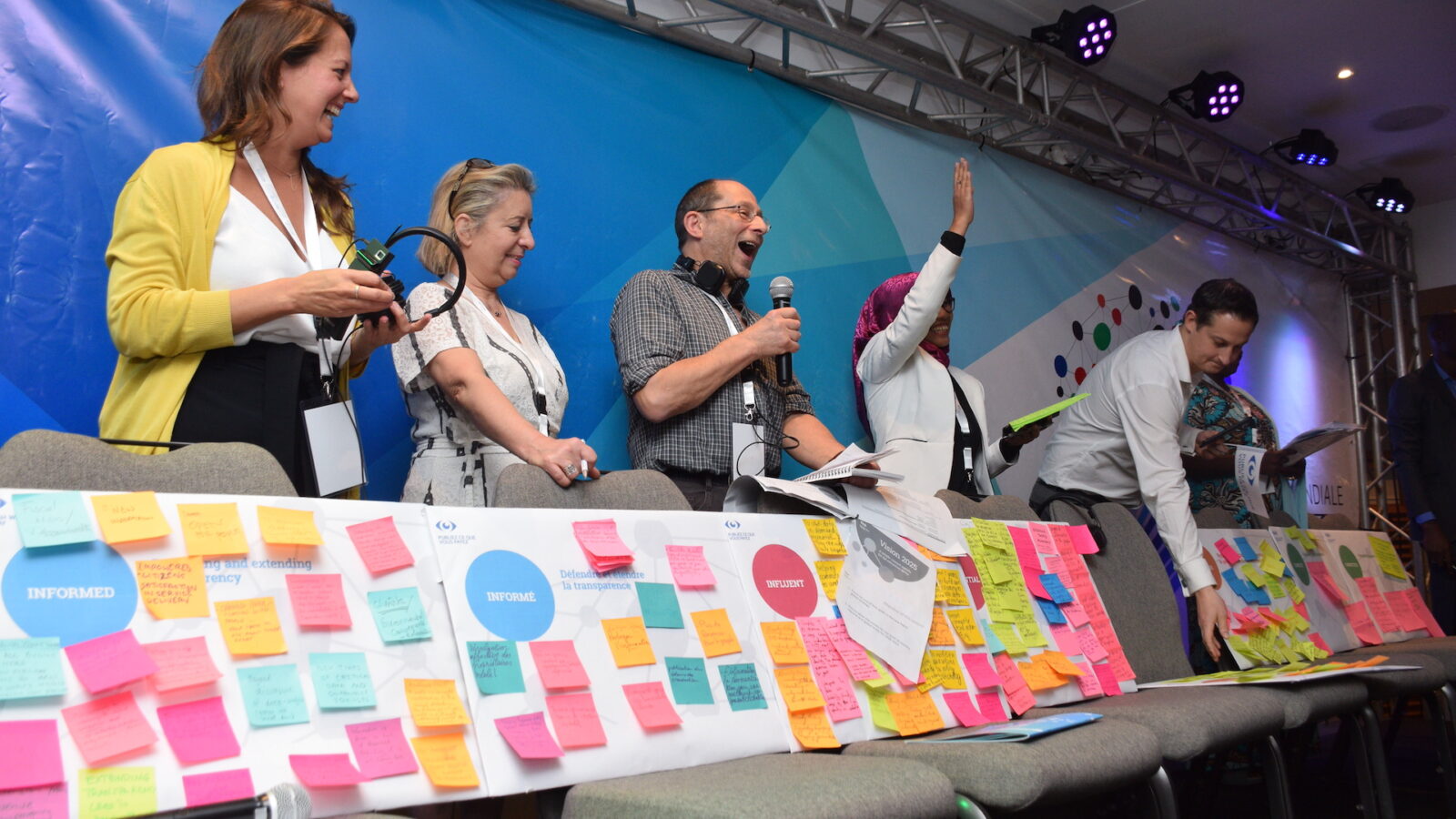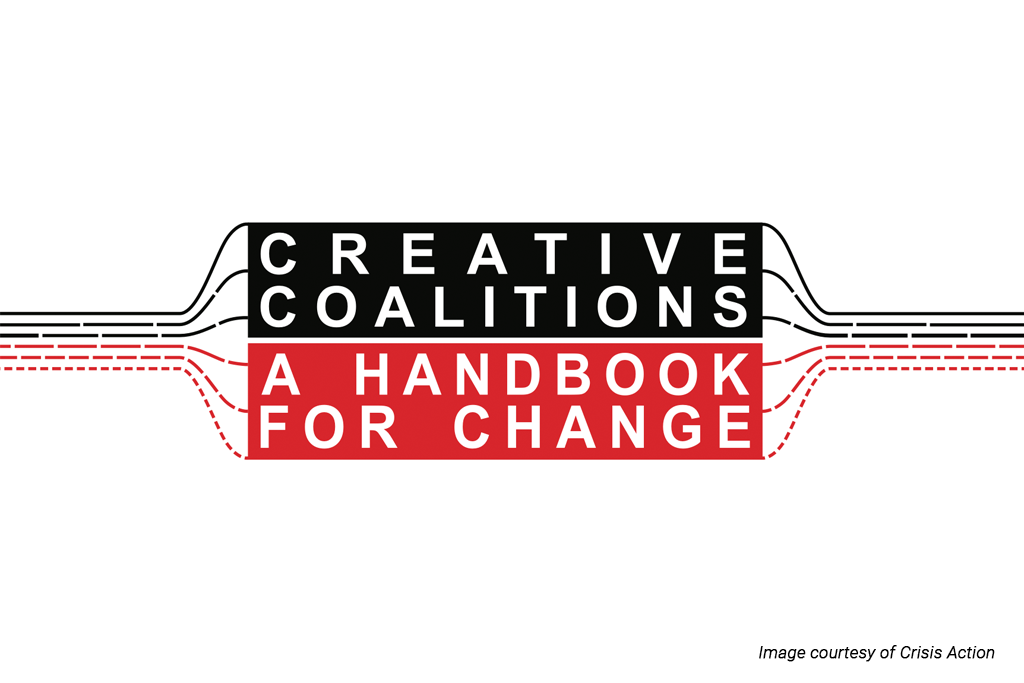The form that national PWYP coalitions take is largely determined by their purpose, their context, the vision of their leadership and the aspirations of their members. This form ideally evolves in relation to changing circumstances. Until 2020, the PWYP-US coalition had traditionally operated in a way that fits many of the attributes that practitioner-theorists use to define highly effective coalitions. However, the coalition had repeatedly faced a number of obstacles that impacted its progress in achieving its key objective. Coalitions can be exceptionally motivated, skilled and organised, and yet not ‘win’ due to an array of external factors affecting the wider context in which they work. In response, the PWYP-US coalition – modelled around the achievement of a particular outcome and for a long time highly functional in that pursuit – chose to re-think its strategy and broader vision for its work, in order to remain relevant and effective, both domestically and internationally. This required some strategic thinking and a re-shaping of the coalition to align with its members’ priorities and their aspirations. The story of this evolution – of how the PWYP-US coalition stood back and adapted its model, facilitated through skilled female leadership, forms an interesting case study about how PWYP coalitions can adapt to stay relevant and inclusive.
Coalition Purpose up to 2020
Founding members of the PWYP-US coalition modelled their strategy on the global PWYP campaign which sought to reverse the resource curse. They aimed to do this specifically through strengthening US corporate financial disclosure requirements. By pursuing this objective, the coalition intended to strengthen accountability both in the US and globally, given the reach of publicly listed US extractives corporations, which have outsized global impact given the US’s role as a major capital market. The objective represented a clearly articulated shared purpose for the coalition that created cohesion around a desired external result – one that connected with the missions of its members. The objective also represented a clear and unique value proposition within the US civil society ecosystem.
Significance of the ‘Section 1504’ objective
The PWYP-US coalition sought to pass a law requiring the US Securities and Exchange Commission (SEC) to develop and implement a regulation in which US oil, gas and mining companies must disclose the payments they make to governments. In 2010, this objective was achieved with the passage of Section 1504 of the Wall Street Reform and Consumer Protection Act. Over time coalition members’ skills have deepened through the long-haul fight for a strong implementing rule for Section 1504 and the coalition includes a range of relevant expertise and access. Within the core of the coalition, different organizations bring a range of expertise, from understanding the US regulatory process, engaging like-minded investors and industry associations, developing compelling case studies, as well as experience successfully using different advocacy modalities.
Why the coalition had to adapt
The PWYP-US coalition’s success in securing Section 1504 in 2010 helped to catalyse similar laws in 30 countries (including Canada, the whole of the EU, Norway and the UK) and contributed to developing a similar disclosure requirement within the EITI with its implementing countries. However, the SEC’s implementing rule for Section 1504 has not yet gone into effect; blocked by relentless corporate and political opposition. Despite many hard-fought, incremental victories, the legal and political strikes against a strong implementing rule amid changing political circumstances, have impeded coalition success in this key objective.
Fossil fuel companies and their allies in the US have mounted a concerted effort to prevent the SEC from developing a strong regulation that both meets the Congressional intent of Section 1504 as well as aligns with the global standard for disclosure. The dissolution of USEITI added to US coalition concerns and the capture of public institutions by fossil fuel interests remained a constant obstacle. In January 2017, a majority of US Representatives and US Senators invoked the Congressional Review Act and voted to vacate the Section 1504 rule. In effect, this vote negated years of diligent advocacy efforts by the coalition to inform the development of a strong implementing rule.
Recruiting new leadership to ‘step back’ and rethink the coalition model
These events, alongside a rapidly evolving domestic extractives sector under the new Trump administration, frustrated coalition momentum. Coalition members often found themselves stretched thin, having to prioritize other important areas of their work that were threatened by the Trump administration’s agenda. This new political context offered little hope for successfully securing another strong implementing rule and weakened member’s morale. In 2020, the Steering Committee agreed that the coalition should step back and reassess the coalition’s vision.
After hiring a new coalition Director in 2019, the Steering Committee seized the opportunity to task them with developing a new strategic direction for the coalition. Throughout the coalition’s history, US national coordinators (called Directors in the US context) have been expert extractives advocates themselves and have offered expert leadership in planning campaigns and facilitating important strategic discussions. Coordinators have typically guided the coalition to be highly action oriented, responsive and goal focussed, with clearly assigned tasks and plans of activities, and with an understanding of members skills and resources.
While the coalition was involved in many discussions about its purpose and how it could effectively contribute to its goal of reversing the resource curse, the Director had to both keep members engaged while also working to scope out its future. The ability of the Director to bridge this gap forms a good example of effective women’s leadership within the PWYP network. Notably, the coalition leadership including the Steering Committee and Director previously had a majority of women, one of the few in the PWYP world. The current Steering Committee is composed of as many women as men.
The Steering Committee and the new Director agreed that the remit of the coalition needed to expand. If the aim of the coalition was to contribute to reversing the resource curse, the sole pursuance of a strong implementing rule for Section 1504 was not effective, since the regulation was a means to an end, but not an end in itself. They therefore agreed to broaden the strategy while retaining the objective to pursue full implementation of Section 1504. The new Director therefore set about exploring what other value the coalition might collectively bring to addressing the resource curse in the US context and whether there could be a new shared vision for the coalition.
Leading the process of renewal – from the centre
Continued member buy-in is an essential feature of an effective, agile coalition, and the new Director, included in her consultations the question about whether members felt the coalition needed to continue to exist or not. But before this question could be asked satisfactorily, the Director needed to articulate the possible value-add that the coalition could contribute that it had not been doing to date : that is, whether a coalition approach could achieve more than individual members to make progress on specific, ‘resource curse’ objectives that are of interest to members; and whether such an approach could constitute a real niche and value-add in the context of the civil society ecosystem within the US.
Beginning in March 2020 therefore, the new Director proposed and scoped-out potential new avenues through which the coalition could add real value through collective advocacy. She consulted with members and former members about their interests and expectations to enable her to better mirror the concerns and interests of the broader coalition. She also conducted a theory of change process with core members to help identify blocks to progress and new means to contribute to the overall goal of ending the resource curse. She presented the results of the process to members in the form of a new draft coalition strategy.
Outcomes of the re-think
The process led to a number of outcomes:
- By leading a theory of change process, the Director enabled members to acknowledge that coalition progress was stalled by unforeseen factors not accounted for in campaign plans nor theories of change, namely the capture of specific state institutions by fossil fuel companies. The coalition had to therefore either formulate a means to address this block or accept that the objective was beyond achievement.
- Members were therefore able to agree to new campaigns avenues (scoped out by the Director) that were needed to address these blocks.
- The process also enabled members to agree that securing a strong implementing rule for Section 1504 continued to be important but was not the only means that the coalition could contribute to strengthened accountability. Members agreed that the coalition could contribute to other routes – including supporting the struggles of community networks.
- The process enabled members to consider balancing its commitments to championing global disclosure standards with the needs of a broader membership that had other domestic priorities related to the resource curse. Subsequently the coalition was able to pivot towards the agendas of its members with a domestic focus, while retaining its long-held championship of US and global disclosure standards.
- Some members articulated that they no longer had an appetite for working on Section 1504 but identified continuing value in participation in the coalition through new objectives that chimed more closely with their missions in supporting affected communities, or pursuing new disclosure requirements aimed to increase accountability for fossil fuel companies’ role in contributing to the climate crisis.
- As intended, the process enabled the Director to recruit the interested new members.
Members’ consensus on these outcomes enabled the coalition to develop a new strategy to include new approaches:
- Challenging the democratic distortion created by fossil fuel industry influence on public institutions, decision-makers and influencers at a federal level.
- Challenging public policies that support the fossil fuel industry including subsidies and fiscal reform and ‘finishing the job on transparency’ in the context of the global energy transition by exploring new areas of disclosure needed from companies and governments.
- Challenging the economics of extraction in support of just transition (in line with the global energy transition positions [SR1] adopted by PWYP’S Global Council) by working with communities and state level groups to provide fiscal analysis that challenges myths about fossil fuel social contribution.
These new, complementary approaches speak to the missions of a broader constituency of members. The coalition now seeks to re-engage and renergise its membership on this basis, operationalise its strategy, engage with new networks and pitch to funders.
Learning points
- Members’ buy-in and attention is the critical ingredient without which a coalition does not exist. A shared vision that articulates the potential value the coalition can bring is vital to this. Without it the coalition loses relevance.
- One of the key characteristics of effective coalition management posited by theorists is the ability to facilitate reflection on the continued utility of the coalition, progress, outcomes, impact and learning. Theorists therefore recognise that an important part of good coalition management involves enabling the coalition to stand back and review theories of change and the value offering; while also monitoring the impediments to participation of members and ensuring that members receive the benefit they expect from participation. Balancing the interests of different members and monitoring and adapting to context are a perpetual reality for coalitions.
- Coordinators, boards and steering committees need to be reflective about the purpose and relevance of the coalition and bring those questions back to the membership to reflect on.
- Coalitions can get stuck in the pursuit of particular ‘origin’ objectives and lose sight of their potential contribution to the bigger picture of tackling the resource curse.
- Reviews of progress can be helpful in enabling advocates to identify and acknowledge significant blocks to progress that require them to rethink their strategies.
- Driving a coalition rethink can be a major exercise and requires leadership and significant investment by the Director/National Coordinator (or someone else tasked for that role). This can include scoping out of new strategies and campaigning avenues to articulate these back to members as possibilities for agreement. Where a coalition has stagnated a motivated and skilled National Coordinator can play a role in ‘holding’ the coalition while scoping out new options for members to consider. This process requires the agreement and support of core members and steering committees.
- Even relatively short periods of stagnation can make a coalition redundant as space is ceded to other organisations and networks and credibility with external actors diminishes quickly.
- At an international level, PWYP may need to pay increasing attention to how coalitions are domesticating the PWYP agenda. The new directions and issues that coalitions are taking on in order to remain relevant to the domestic fight to reverse the resource curse should be identified and absorbed by PWYP internationally and reflected in ongoing strategy development and thinking and in periodic adjustments to the global PWYP strategy. Issues including energy transitions and supporting people’s movements may become of increasing relevance relative to the traditional ‘origin’ objectives on data disclosure and data use.
- More support from the PWYP Secretariat and from within the network would be useful in helping national coordinators navigate complex coalition dynamics and in strategically managing coalitions. Managing a coalition to meet shared advocacy goals is a job in itself, but asking probing questions about relevance, shared value (or lack thereof), and attempting to evaluate a coalition’s overall health represents a whole other level of challenge. Most coordinators will have to work through these sorts of complex dynamics at some point. Space for sharing, learning and expert support could greatly help coordinators feel more equipped to handle this side of the work.
Written by Brendan O’Donnell based on interviews with PWYP-US Director Kathleen Brophy.
PWYP-US Characteristics
| Coalition | PWYP-US Coalition |
| Age in 2021 | 17 years old, one of the most well-established within the global PWYP network. |
| Membership shape | EGG shaped: Broad membership of 10-12 highly active ‘core members’ and 28 more members |
| Membership size | LARGE: 40 members |
| Unique value proposition | Advocacy on corporate extractive financial disclosure in the US
Expert support to people’s movements |
| Major recent coalition internal challenges | Acknowledging the limits of progress imposed by capture of state institutions by fossil fuel interests. Rethinking strategy and recreating cohesion in this context.
Balancing implicit commitments to championing global disclosure standards with the needs of a broad membership with domestic priorities. Rethinking and broadening value from advocating for data disclosures to contributing more directly to peoples’ movements by offering expertise. |
| Major ongoing contextual challenges | State capture by extractives industry
Hostile and powerful opposition Threats to civic space of community groups PWYP-USA aims to work with |
| Member mix | Members are drawn from development, faith-based, human rights, environmental, financial reform, and anti-corruption organizations representing over 2.5 million constituents throughout the United States. |
| Diversity in coalition leadership | HIGH: The coalition has been one of the few (3) in the world with a women majority Steering Committee. The current Steering Committed is half female, half male. |
| Is the membership diverse in terms of different types of agency functions? | HIGH: Diverse and expert – journalism, law, human rights, extractives expertise, grassroots connection, thinktanks |
| Diversity of membership (groups represented) | MEDIUM: Diverse group of NGOs including NGOs/INGOs that work with citizen’s groups
Fewer direct connections with community-based organisations and networks (although it is an ambition) |
| Diversity in terms of promoting rights of specific groups explicitly in advocacy | LOW: Not specifically, but this may evolve as the coalition moves further towards supporting community-based networks more directly. Not promoting women’s, youth or indigenous people’s rights specifically in advocacy, although they feature in case studies which are conscious of excluded groups and the coalition conducts gender and other diversity training. |
| Governance style | PWYP-US is governed by a Steering Committee consisting of representatives from five coalition members and with governance standards agreed upon by the wider coalition. |
| Leadership | Full time salaried Coordinator (Director)
Steering group of 5 organisations provide significant leadership support and engage and outreach to membership Notable for its women-led leadership (coordinators) over several years |
| How do members join? | As per PWYP rules https://www.pwyp.org/wp-content/uploads/2019/01/2022_PWYP-Governance-manual-updated_EN.pdf |
| How do members participate, coordinate and communicate? | Calls every other week. 10 – 25 people participate. Agenda is cued-up discussions ahead of time. Meetings feature specific groups, brainstorms, member spotlights, member reports / new members, discussions. The coalition’s listserv is major means to communicate but not for open strategizing as it includes non-members. Smaller working-groups for strategizing; different members chair different groups. People leading on moving the work forward. Now attempting to bridge buy-in to commitment and specific member roles., current transition. Dispersed responsibility – health indicator of the coalition.
Steering Committee has a terms of reference in governance guidelines, available to whole coalition, roles document with different decision-making power according to the Steering Committee, Director and membership. Minutes of Steering Committee meetings are shared with members quarterly. |
| How formal is the coalition? | Formal. |
| Are goals aligned with PWYP strategy or do coalitions have their own criteria? | Highly aligned. |
| Links to PWYP peers | Coalition core is highly connected to Canadian and European PWYP Coalitions who have been jointly strategizing and collaborating in advocating for global disclosure standards for listed companies for two decades. Coalition INGO members also have vast networks of connections with PWYP members globally and have collaborated extensively in pursuit of mutual transparency gains. Less apparent that there is exchange between PWYP-US coalition and other coalitions on how they formulate strategy. |
| Member organisations | Action Aid USA. American Jewish World Service. Amnesty International USA. Bank Information Center. CARE USA. Catholic Relief Services. Columban Center for Advocacy and Outreach. CorpWatch. Crude Accountability. EarthRights International. Earthworks. EG Justice. EIRIS Conflict Risk Network. Environmental Defense Fund. Friends of the Earth. Gender Action. Global Financial Integrity. Global Rights. Global Witness. Government Accountability Project. Human Rights Watch. International Budget Project. International Labor Rights Forum. Justice in Nigeria Now. Maryknoll Office for Global Concerns. Micah Challenge USA. Natural Resource Governance Institute. ONE Campaign. Open Society Policy Center. Oxfam America. Pacific Environment. Presbyterian Church USA. Project on Government Oversight. Robert F. Kennedy Center for Human Rights. Sustainable Energy & Economy Network. The Borgen Project. United Methodist. General Board of Church and Society. United Steelworkers. United to End Genocide |
Appendix
Best practice models for coalitions
Summarised from What Makes an Effective Coalition? Evidence-based Indicators of Success, Jared Raynor, TCC Group, The California Endowment (2009)
Coalition effectiveness – leadership characteristics
- Coalitions have a clearly articulated shared purpose/vision that builds cohesion
- Coalition clearly express their desired external results that connects to the missions of members (goal destination)
- Articulation of why this coalition is necessary as opposed to alternatives (value proposition) and why it potential for effectiveness outweighs the costs of membership
- Clear rules for how the coalition will think, decide and act
- Strong leadership to keep the coalition moving forward, resolve conflict, ensure trust and should reflect breadth of coalition without being comprehensive. In some cases leadership may involve core members. Needs to be able to lead.
- Balance meaningful discussion with action and should be action oriented.
- Transparent in decision-making processes – not necessarily consensus but should allow member input and be transparent
- Strategic membership that includes those with the right purpose
Coalition effectiveness – adaptive characteristics
- Coalition’s ability to monitor advocacy environment to enable to coalition to respond strategically to opportunities for greatest impact
- Effective planning – strategic and activities
- Evaluate and reflect on progress
- Map members skills and resources and contributions
- Monitor impediments to participation
- Resource development – ie how coalition can identify resources needed and attempt to fill these (resources means time, skills, expertise, relationships, physical space, other networked resources and fundraising)
- Promote inter-member collaboration
Management Characteristics
- Frequent and productive communications – that build trust and drive members towards action, in appropriate languages
- Coalition management ensures that members receive the benefit they expect from participation and members are surveyed (formally or informally) to check this
- Clearly assigned tasks
- Goal focussed – sense of collective accomplishment
- Clarity of membership / staff goals
- Conflict management including addressing power differentials and tolerating healthy tensions and differences
- Record keeping of coalition activity and progress / outcomes / impact / learning to enable communications and evaluation
Technical characteristics
- Membership diversity to enable reach and expertise to meet specific goals. Narrow membership to address specific goals can be legitimate. Challenges where the capacity and even ability to understand information is limited among some members – creates capacity building responsibility (which might be an aim of the coalition).
- Staffing – although if a coalition can’t meet its goals without paid-for staffing it doesn’t mean it will do so with it. Five roles coach, director, linking agent, doer and coordinator. If ‘doer’ is the main role may ring alarm bells.
- Translating data into useful information – i.e. a meaning-maker role
- Able to close policy capacity gaps – even through partnership with orgs outside the coalition
- Space, equipment funding
- Ability to marshall resources and handle internal competition for resources. Includes funding for staff overheads that can be challenging (as opposed to activities) ability to make a compelling argument for this cost (as opposed to in-kind support from members, where they host coordinators or chair the coalition on rotation). Incorporated coordination is not always the best way to go
- Fiscal agency – sometimes necessary to raise funds but not always
Cultural Characteristics
- Trust – through transparency, communication and inclusion
- Respect for members
- Safe respectful dissent
- Unity – being able to present a united front
- Sensitive to power differentials – minimise the effects
Assessing the outcomes / impact
- Developing a continuum of indicators and measures
- Enabling an assessment of the extent to which the coalition is meeting its objectives
- Gaging whether the coalition is reaching its goal destination and how effectively?
- Checking in on the legitimacy and relevance of the coalition











